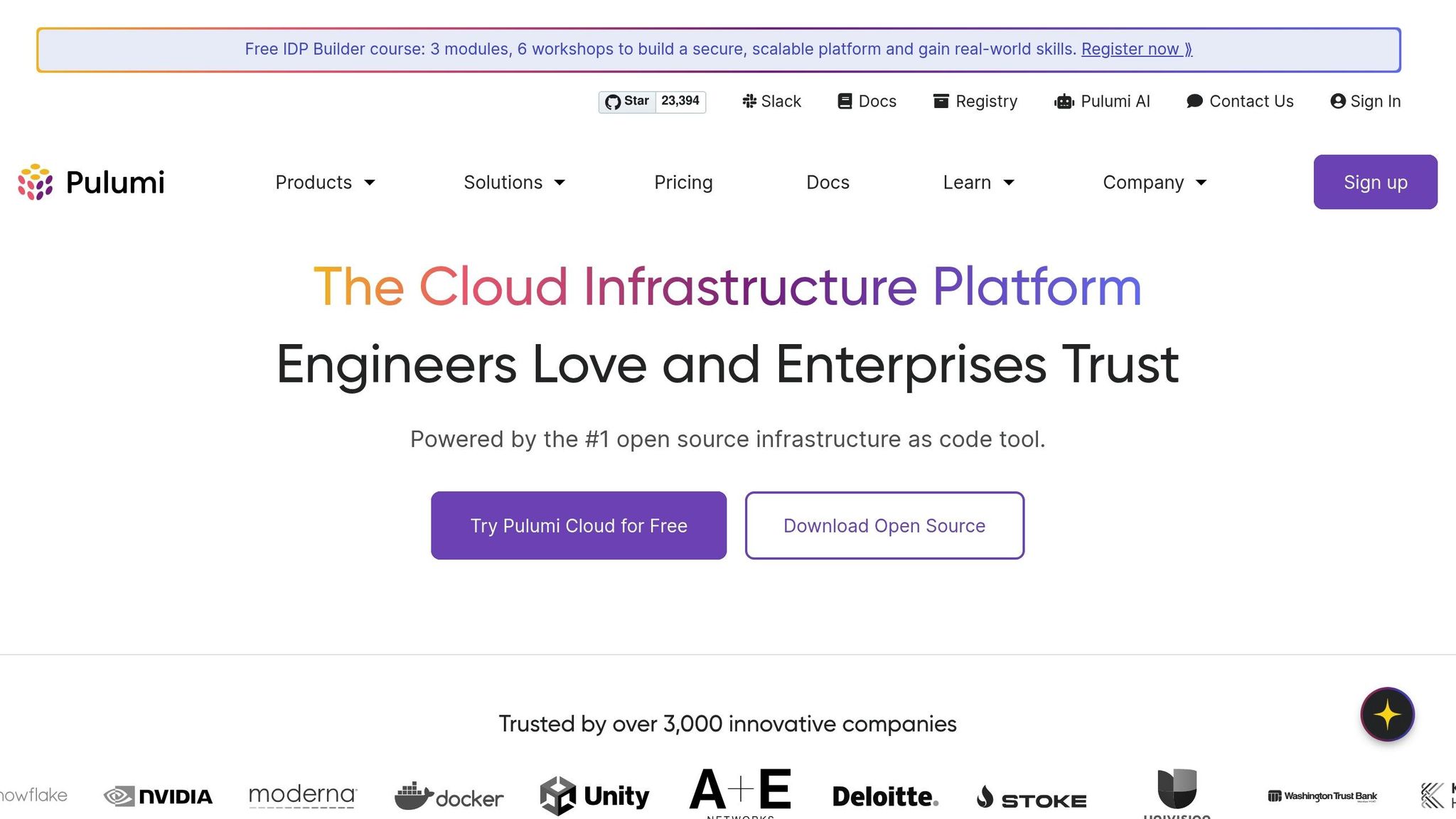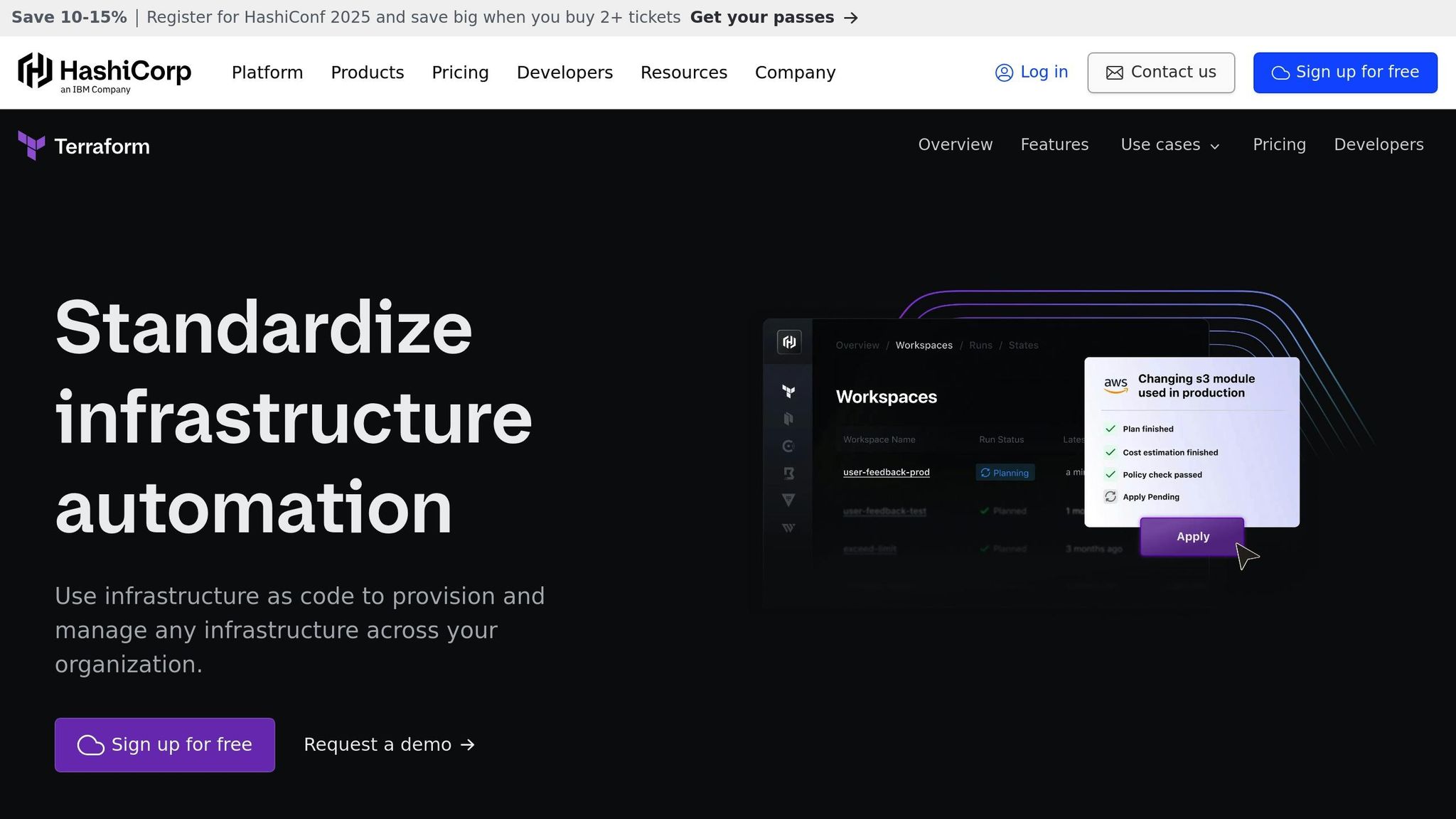Pulumi and Terraform are two popular Infrastructure as Code (IaC) tools, each offering distinct approaches to programming languages. Here's a quick breakdown:
- Pulumi: Supports eight general-purpose languages like Python, TypeScript, Java, and Go. This allows developers to use familiar tools and integrate infrastructure code with application code seamlessly. Pulumi uses an imperative coding style, enabling dynamic constructs like loops and conditionals.
- Terraform: Relies primarily on its declarative HashiCorp Configuration Language (HCL), which simplifies defining infrastructure states. For those preferring general-purpose languages, Terraform offers the Cloud Development Kit for Terraform (CDKTF), supporting TypeScript, Python, and others.
Key Differences:
- Pulumi caters to developers comfortable with coding, offering flexibility through reusable components and integration with existing workflows.
- Terraform appeals to teams prioritising simplicity and readability, with HCL designed for infrastructure clarity.
Your choice will depend on your team's expertise and project complexity. Pulumi suits development-heavy teams, while Terraform is ideal for infrastructure-focused setups.
Quick Comparison:
| Feature | Pulumi | Terraform |
|---|---|---|
| Languages Supported | Python, TypeScript, Java, Go, C#, YAML | HCL (primary), CDKTF for TypeScript, Python |
| Coding Style | Imperative | Declarative |
| Learning Curve | Requires programming knowledge | Easier for beginners with HCL |
| Extensibility | Full language features, custom components | Custom providers via Go |
| Community | Smaller, growing | Established, mature |
Both tools are effective but serve different needs. Assess your team's skills and project requirements to choose the right one.
1. Pulumi

Programming Language Support
For UK-based teams aiming to streamline cloud infrastructure management, Pulumi's support for multiple programming languages is a major asset. It works with TypeScript & JavaScript (Node.js), Python, Go, C#, VB, F# (.NET), Java, and Pulumi YAML [1]. This wide-ranging compatibility connects with large developer communities across the globe [3].
Pulumi allows developers to use widely-adopted general-purpose languages for infrastructure as code. This approach taps into vast existing developer communities...[3]
What stands out about Pulumi's multi-language support is that every language it supports comes with full functionality. Teams can access the complete range of cloud services available in the Pulumi Registry [2]. This ensures that UK developers can stick with their preferred programming languages without losing access to any cloud provider features.
This versatility reinforces Pulumi's philosophy of providing consistent infrastructure definitions, regardless of varying coding styles.
Coding Style
Pulumi adopts an imperative coding approach, incorporating familiar elements like variables, loops, conditionals, and functions. It aligns perfectly with standard coding practices. Additionally, Pulumi integrates with each language's native package manager - such as npm, pip, or NuGet - allowing teams to reuse existing libraries alongside infrastructure code. This approach enables the creation of sophisticated, reusable components.
By sticking to these familiar coding conventions, Pulumi makes it easier for developers to integrate with established programming ecosystems, further enhancing flexibility and scalability.
Extensibility
Pulumi's extensibility lies in its ability to integrate seamlessly with native programming ecosystems. Teams can extend functionality by building custom infrastructure components using existing libraries and frameworks within their chosen language. Furthermore, as an open-source platform, Pulumi allows organisations to add support for additional languages [1][2].
The licensing structure for the supported languages offers adaptability for enterprise-level use:
| Language | Licence |
|---|---|
| C# | MIT (.NET Core) |
| Java | GNU v2.0 (OpenJDK) |
| JavaScript | MIT (ECMAScript), BSD-style 3-Clause (V8) |
| Go | BSD-style 3-Clause |
| Python | BSD-style Python Software Foundation |
| TypeScript | Apache 2.0 |
| YAML | Creative Commons Attribution |
Developer Experience
Pulumi focuses on delivering a seamless developer experience by leveraging familiar tools and workflows. Developers can use their preferred IDEs, debuggers, and testing frameworks, with full support for code completion, syntax highlighting, and error detection.
The platform also supports integrating IaC (Infrastructure as Code) directly into existing projects and workflows [3]. This means infrastructure code can sit alongside application code within the same repository, fostering better collaboration between development and operations teams. This approach is especially beneficial for UK organisations embracing DevOps practices.
For teams managing existing codebases, Pulumi enables infrastructure components to share utility functions, configuration management, and even business logic with application code. This reduces redundancy and ensures consistency across the entire tech stack.
2. Terraform

Programming Language Support
Terraform takes a different approach from Pulumi by relying primarily on the HashiCorp Configuration Language (HCL), a declarative language designed specifically for defining infrastructure resources [5]. This means that teams using Terraform need to learn HCL, regardless of their prior programming experience.
The main purpose of the Terraform language is declaring resources, which represent infrastructure objects. All other language features exist only to make the definition of resources more flexible and convenient.[5]
For organisations in the UK that prefer working with familiar programming languages, Terraform offers the Cloud Development Kit for Terraform (CDKTF). This tool allows teams to use TypeScript, Python, Java, C#, and Go while still leveraging Terraform’s core capabilities [4][7].
Coding Style
Terraform’s HCL adopts a declarative style, enabling users to specify the desired final state of their infrastructure [9]. Its design prioritises human readability and collaboration, making it easier for teams to work together. Research shows that HCL’s readability can boost productivity and reduce onboarding times for new team members [8][9].
HCL also supports JSON-compatible syntax, allowing for added flexibility. Features like comments and clean formatting make it easier to navigate and manage configuration files, which is crucial since poorly formatted files can lead to a 50% increase in error rates [8]. These qualities make HCL an effective choice for teams handling complex infrastructure setups.
Extensibility
Terraform stands out for its customisation options and extensibility, particularly for UK-based organisations with unique infrastructure needs. Its open-source nature allows teams to create custom providers and modules to handle specific resources or use cases not covered by the Terraform Registry [11].
The platform’s plugin architecture is central to this extensibility, enabling users to go beyond the core toolset [11]. For example, provider-defined functions allow teams to integrate custom capabilities directly into their configurations. As of Terraform 1.8, these functions are supported by major providers like AWS, Google Cloud, and Kubernetes [10].
Developing custom providers requires knowledge of Go, as HashiCorp only supports Go for this purpose [6]. For teams building tailored solutions, Terraform includes advanced features like the moved block, which helps refactor configurations without disrupting the existing resource state [10].
Developer Experience
Terraform delivers a developer experience focused on state-based infrastructure tracking and declarative configuration management [7]. The platform uses a state file to keep track of deployed resources, giving teams a clear view of their infrastructure. However, the HCL-first approach can present a learning curve, as developers need to familiarise themselves with Terraform’s syntax and conventions. Despite this, surveys indicate that over 70% of developers eventually come to appreciate HCL for its clarity [8].
For teams that prefer procedural programming, CDKTF provides an alternative. When working with CDKTF, TypeScript is often the preferred language due to its ability to generate construct packages [4]. This is particularly useful for UK teams with strong TypeScript expertise. Terraform also integrates well with existing development workflows and infrastructure tools, making it easier to incorporate into established toolchains [12].
That said, teams should carefully evaluate any modules sourced from the Terraform Registry or third-party providers to ensure they are free of vulnerabilities and are actively maintained [11].
To maintain code quality, it’s essential to follow best practices like using remote shared state locations for production environments and running commands such as terraform fmt and terraform validate regularly [13]. These steps become even more crucial as infrastructure complexity grows within UK organisations.
Pulumi vs Terraform: An In-Depth Comparison
Need help optimizing your cloud costs?
Get expert advice on how to reduce your cloud expenses without sacrificing performance.
Pros and Cons
When comparing Pulumi's flexibility with Terraform's declarative approach, it's essential for UK organisations to weigh the strengths and challenges of each platform. Both have distinct benefits, but they also come with trade-offs that can impact infrastructure as code (IaC) strategies. Here's a closer look.
Pulumi's Advantages
Pulumi stands out for its multi-language support, allowing developers to work with popular general-purpose programming languages. This taps into vast developer communities and established ecosystems, making it easier to integrate with existing workflows [3]. It also reduces repetitive coding through dynamic reuse [3]. For large-scale projects, Pulumi's design scales efficiently, often eliminating the need for additional tools or complex custom solutions that might be necessary with HCL configurations [3].
Terraform's Advantages
Terraform is built around its HCL syntax, which is known for being easy to read and collaborate on. This makes it simple for teams to understand the infrastructure's current state and its requirements. Its state management system provides clear visibility into deployed resources, ensuring transparency.
Terraform also boasts a mature ecosystem. The Terraform Registry features thousands of pre-built modules, and its plugin architecture allows teams to develop custom providers for unique use cases. These features make it a reliable choice for many organisations.
Key Disadvantages
| Aspect | Pulumi | Terraform |
|---|---|---|
| Learning Curve | Requires familiarity with general-purpose programming languages | Requires learning HCL, which may be less intuitive for some developers |
| Ecosystem Maturity | Smaller community due to being a newer platform | HCL's fixed syntax may limit broader engagement within development teams [3] |
| Complexity Management | Supports dynamic code reuse, reducing redundancy | May require custom tools to handle configuration redundancy [3] |
| Future-Proofing | Supports multiple languages, offering flexibility [3] | Fixed syntax may restrict adaptability [3] |
Real-World Impact
The practical implications of choosing between Pulumi and Terraform often come down to how these platforms perform in real-world scenarios. James Forcier, a Staff Software Engineer, shared his experience with Pulumi:
We've spent a lot of time building our internal developer platform. We moved from a lower-level Terraform and HCL-based interface to Pulumi, letting us use a custom, higher-level, and much simpler-to-use YAML schema we've defined. We've made cloud infrastructure really easy to use for our developers.[14]
For simpler infrastructure tasks or multi-cloud deployments, Terraform remains a strong option, especially for teams that prefer a declarative style over procedural programming. These real-world examples highlight the importance of aligning the choice of tool with the team’s expertise and the project’s complexity.
Strategic Considerations for UK Organisations
Deciding between Pulumi and Terraform often comes down to balancing flexibility with simplicity. The expertise of the team plays a crucial role. Development-heavy teams may thrive with Pulumi's programming language options, while infrastructure-focused teams might find Terraform's declarative approach more accessible.
Project complexity is another key factor. Straightforward deployments might not require Pulumi's advanced programming capabilities, whereas dynamic, intricate environments can benefit significantly from its flexibility.
For UK businesses, especially those collaborating with Hokstad Consulting, the decision should reflect organisational goals, team skills, and long-term infrastructure strategies. By understanding these trade-offs, companies can choose the platform that best aligns with their DevOps transformation and cloud optimisation efforts.
Conclusion
Choosing the right tool depends on your organisation's specific needs. Both Pulumi and Terraform provide strong infrastructure as code (IaC) capabilities, but they cater to different team strengths and project demands.
One major distinction lies in their approach to programming languages. Pulumi supports widely used languages like Python, TypeScript, and Go, allowing teams to work with tools they already know. Terraform, on the other hand, uses its own domain-specific language, HCL. While HCL is designed to be straightforward, it may require some time for new users to learn. These language differences also influence aspects like testing, licensing, and operational usability.
When it comes to testing and maintainability, Pulumi stands out with built-in support for unit, property, and integration testing, which can improve code quality. Licensing is another factor to consider. Terraform's switch to the Business Source License in August 2023 [15] has led some organisations to reevaluate their options, whereas Pulumi continues to operate under the Apache 2.0 license.
The choice between these tools often comes down to your team's expertise and the complexity of your projects. Pulumi's flexibility and seamless integration with existing programming environments can simplify automation and reduce overhead. On the other hand, Terraform's widespread use and standardised workflows make it a reliable option, especially for teams managing multiple client environments.
For instance, a UK-based fintech company with a strong Python development team might find Pulumi's programming compatibility advantageous. Meanwhile, a managed services provider handling a variety of clients might lean towards Terraform for its consistency and established practices.
Given the complexities involved, many UK businesses turn to expert consultation for guidance. Hokstad Consulting offers tailored assessments of infrastructure, team capabilities, and business goals, helping organisations implement solutions that optimise performance, compliance, and costs in line with local requirements.
As IaC tools and automation continue to evolve, it's essential to periodically review your platform to ensure it aligns with your DevOps strategy and cost management objectives.
FAQs
How do Pulumi and Terraform differ in their use of programming languages, and what does this mean for developers?
Pulumi and Terraform take different paths when it comes to programming languages, and this choice can shape the overall developer experience. With Pulumi, you can write infrastructure as code using popular programming languages like Python, JavaScript, TypeScript, Go, C#, and Java. This approach allows developers to stick with tools and workflows they already know, making it easier to integrate infrastructure management into existing projects and maintain the code long-term.
Terraform, however, relies on its own declarative language called HashiCorp Configuration Language (HCL). HCL is specifically designed for configuring infrastructure and is relatively straightforward to pick up. That said, it might feel less natural for developers who are more comfortable working with general-purpose programming languages. Ultimately, the decision between Pulumi and Terraform often hinges on whether your team prioritises flexibility and alignment with software development practices or prefers a dedicated and simple language for infrastructure tasks.
What should UK organisations consider when deciding between Pulumi and Terraform for infrastructure as code?
When deciding between Pulumi and Terraform, UK organisations should think about their programming language preferences. Pulumi works with popular languages like Python, TypeScript, and Go, which might appeal to developers already comfortable with these. On the other hand, Terraform relies on HCL (HashiCorp Configuration Language), a domain-specific language tailored for infrastructure as code.
Another important consideration is state management. Pulumi defaults to storing state in the cloud, whereas Terraform uses local files or remote backends, which is a more traditional method. This difference can impact how teams handle collaboration and version control.
Finally, take into account the complexity of your environment. Pulumi's flexibility makes it a strong choice for multi-cloud setups, while Terraform benefits from a larger user base and a wealth of documentation. Assess your team's skills, the need for workflow integration, and your organisation's future plans to determine which tool aligns best with your goals.
How does Pulumi's support for multiple programming languages compare to Terraform's use of HCL?
Pulumi offers support for several programming languages, including Python, JavaScript, TypeScript, C#, and Java. This means developers can write infrastructure code using languages they already know, speeding up workflows and making it easier to integrate with existing systems. Plus, it allows teams to reuse code, streamlining the process of managing infrastructure.
In contrast, Terraform relies on its own domain-specific language, HCL. While HCL is specifically crafted for infrastructure as code, it requires teams to learn a new syntax. This can slow down adoption, particularly for teams already comfortable with general-purpose programming languages.
By allowing developers to use their current skill set, Pulumi simplifies onboarding, improves collaboration, and fits seamlessly into established development workflows.
